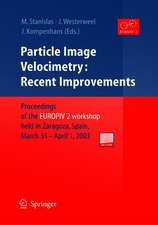Schlieren and Shadowgraph Techniques: Visualizing Phenomena in Transparent Media: Experimental Fluid Mechanics
Autor G.S. Settlesen Limba Engleză Hardback – 25 sep 2001
These techniques are discussed briefly in many books and papers, but there is no up-to-date complete treatment of the subject before now. The book is intended as a practical guide for those who want to use these methods, as well as a resource for a broad range of disciplines where scientific visualization is important. The colorful 400-year history of these methods is covered in an extensive introductory chapter accessible to all readers.
| Toate formatele și edițiile | Preț | Express |
|---|---|---|
| Paperback (1) | 1221.69 lei 6-8 săpt. | |
| Springer Berlin, Heidelberg – 5 oct 2012 | 1221.69 lei 6-8 săpt. | |
| Hardback (1) | 1226.73 lei 6-8 săpt. | |
| Springer Berlin, Heidelberg – 25 sep 2001 | 1226.73 lei 6-8 săpt. |
Preț: 1226.73 lei
Preț vechi: 1496.01 lei
-18% Nou
Puncte Express: 1840
Preț estimativ în valută:
234.74€ • 245.70$ • 195.37£
234.74€ • 245.70$ • 195.37£
Carte tipărită la comandă
Livrare economică 31 martie-14 aprilie
Preluare comenzi: 021 569.72.76
Specificații
ISBN-13: 9783540661559
ISBN-10: 3540661557
Pagini: 400
Ilustrații: XVIII, 376 p. 259 illus., 48 illus. in color.
Dimensiuni: 155 x 235 x 30 mm
Greutate: 0.7 kg
Ediția:2001
Editura: Springer Berlin, Heidelberg
Colecția Springer
Seria Experimental Fluid Mechanics
Locul publicării:Berlin, Heidelberg, Germany
ISBN-10: 3540661557
Pagini: 400
Ilustrații: XVIII, 376 p. 259 illus., 48 illus. in color.
Dimensiuni: 155 x 235 x 30 mm
Greutate: 0.7 kg
Ediția:2001
Editura: Springer Berlin, Heidelberg
Colecția Springer
Seria Experimental Fluid Mechanics
Locul publicării:Berlin, Heidelberg, Germany
Public țintă
ResearchCuprins
1 Historical Background.- 1.1 The 17th Century.- 1.2 The 18th Century.- 1.3 The 19th Century.- 1.4 The 20th Century.- 2 Basic Concepts.- 2.1 Light Propagation Through Inhomogeneous Media.- 2.2 Definition of a Schliere.- 2.3 Distinction Between Schlieren and Shadowgraph Methods.- 2.4 Direct Shadowgraphy.- 2.5 Simple Lens-Type Schlieren System.- 2.6 On the Aspect of a Schlieren Image.- 3 Toepler's Schlieren Technique.- 3.1 Lens- and Mirror-Type Systems.- 3.2 Sensitivity.- 3.3 Measuring Range.- 3.4 Estimating the Sensitivity and Range Required.- 3.5 Resolving Power.- 3.6 Diffraction Effects.- 3.7 Magnification and Depth of Field.- 4 Large-Field and Focusing Schlieren Methods.- 4.1 Large Single- and Double-Mirror Systems.- 4.2 Traditional Schlieren Systems with Large Light Sources.- 4.3 Lens-and-Grid Techniques.- 4.4 Large-Field Scanning Schlieren Systems.- 4.5 Moiré-Fringe Methods.- 4.6 Holographic and Tomographic Schlieren.- 5 Specialized Schlieren Techniques.- 5.1 Special Schlieren CutoffsIll.- 5.1.1 Graded Filters.- 5.2 Color Schlieren Methods.- 5.3 Stereoscopic Schlieren.- 5.4 Schlieren Interferometry.- 5.5 Computer-Simulated Schlieren.- 5.6 Various Specialized Techniques.- 6 Shadowgraph Techniques.- 6.1 Background.- 6.2 Direct Shadowgraphy.- 6.3 “Focused” Shadowgraphy.- 6.4 Specialized Shadowgraph Techniques.- 7 Practical Issues.- 7.1 Optical Components.- 7.2 Equipment Fabrication, Alignment, and Operation.- 7.3 Capturing Schlieren Images and Shadowgrams.- 7.4 Commercial and Portable Schlieren Instruments.- 8 Setting Up Your Own Simple Schlieren and Shadowgraph System.- 8.1 Designing the Schlieren System.- 8.2 Determining the Cost.- 8.3 Choosing a Setup Location.- 8.4 Aligning the Optics.- 8.5 Troubleshooting.- 8.6 Recording the Schlieren Image or Shadowgram.-8.7 Conclusion.- 9 Applications.- 9.1 Phenomena in Solids.- 9.2 Phenomena in Liquids.- 9.3 Phenomena in Gases.- 9.4 Other Applications.- 10 Quantitative Evaluation.- 10.1 Quantitative Schlieren Evaluation by Photometry.- 10.2 Grid-Cutoff Methods.- 10.3 Quantitative Image Velocimetry.- 10.4 Quantitative Shadowgraphy.- 11 Summary and Outlook.- 11.1 Summary.- 11.2 Outlook: Issues for the Future.- 11.3 Closing Remarks.- References.- Appendix A Optical Fundamentals.- A. 1 Radiometry and Photometry.- A.2 Refraction Angle 8.- A.2.1 Small Optical Angles and Paraxial Space.- A.2.2 Huygens' Principle and Refraction.- A.3 Optical Components and Devices.- A.3.1 Conjugate Optical Planes.- A.3.2 Lensf/number.- A.3.3 The Thin-Lens Approximation.- A.3.4 Viewing Screens and Ground Glass.- A.3.5 Optical Density.- A.4 Optical Aberrations.- A.5 Light and the Human Eye.- A.6 Geometric Theory of Light Refraction by a Schliere.- Appendix B The Schlieren System as a Fourier Optical Processor.- B. 1 The Basic Fourier Processor with no Schlieren Present.- B.2 The Addition of a Schlieren Test Object.- B.3 The Schlieren Cutoff.- B.4 Other Spatial Filters.- B.5 Partially-Coherent and Polychromatic Illumination.- Appendix C Parts List for a Simple Schlieren/ Shadowgraph System.- C.l Optics.- C.2 Illumination.- C.3 Miscellaneous Components.- C.4 Optical Mounts.- Appendix D Suppliers of Schlieren Systems and Components.- D.l Complete Schlieren Systems.- D.2 Schlieren Field Mirrors.- D.3 Light Sources.- D.4 Components.- D.5 Focusing Schlieren Lenses.- D.6 Miscellaneous.- Color Plates.
Recenzii
From the reviews of the first edition:
... This reviewer recommends Schlieren and Shadowgraph Techniques: Visualizing Phenomena in Transport Media to anyone interested in optical systems for flow visualization, and other studies benefiting from visualization of physical phenomena of transparent media. Even in the current period of competition for resources, an engineering librarian should carefully consider the customer's needs before deciding not to add this book to the library's collection. (from Applied Mechanics Reviews, 55, 4, B76, July 2002)
"If you use or are interested in schlieren or shadowgraph research, you really need this text. … This book not only covers the theory behind the techniques, but it also shows what is needed to get started, by showing how to design and setup a system." (IEEE Electrical Insulation Magazine, Vol. 19 (6), 2003)
"The author begins with an interesting description of historical background, beginning with the ‘micrografia’ of Hooke (1665). … After explaining basic concepts like the light propagation through inhomogeneous media, the distinction between schlieren and shadowgraph methods are pointed out. … It is an extremely useful book for the users of these techniques." (W. Wuest, Zentralblatt MATH, Vol. 987 (12), 2002)
"Schlieren and shadowgraph techniques are basic and valuable tools in various scientific and engineering disciplines. They allow us to see the invisible: the optical inhomogeneities in transparent media like air, water and glass that otherwise cause only ghostly distortions of our normal vision. This book is intended as a practical guide for those who want to use these methods, as well as a resource for a broad range of disciplines where scientific visualization is important." (ETDE – Energy Database, April, 2002)
... This reviewer recommends Schlieren and Shadowgraph Techniques: Visualizing Phenomena in Transport Media to anyone interested in optical systems for flow visualization, and other studies benefiting from visualization of physical phenomena of transparent media. Even in the current period of competition for resources, an engineering librarian should carefully consider the customer's needs before deciding not to add this book to the library's collection. (from Applied Mechanics Reviews, 55, 4, B76, July 2002)
"If you use or are interested in schlieren or shadowgraph research, you really need this text. … This book not only covers the theory behind the techniques, but it also shows what is needed to get started, by showing how to design and setup a system." (IEEE Electrical Insulation Magazine, Vol. 19 (6), 2003)
"The author begins with an interesting description of historical background, beginning with the ‘micrografia’ of Hooke (1665). … After explaining basic concepts like the light propagation through inhomogeneous media, the distinction between schlieren and shadowgraph methods are pointed out. … It is an extremely useful book for the users of these techniques." (W. Wuest, Zentralblatt MATH, Vol. 987 (12), 2002)
"Schlieren and shadowgraph techniques are basic and valuable tools in various scientific and engineering disciplines. They allow us to see the invisible: the optical inhomogeneities in transparent media like air, water and glass that otherwise cause only ghostly distortions of our normal vision. This book is intended as a practical guide for those who want to use these methods, as well as a resource for a broad range of disciplines where scientific visualization is important." (ETDE – Energy Database, April, 2002)
Textul de pe ultima copertă
Schlieren and shadowgraph techniques are basic and valuable tools in various scientific and engineering disciplines. They allow us to see the invisible: the optical inhomogeneities in transparent media like air, water, and glass that otherwise cause only ghostly distortions of our normal vision.
These techniques are discussed briefly in many books and papers, but there is no up-to-date complete treatment of the subject before now. The book is intended as a practical guide for those who want to use these methods, as well as a resource for a broad range of disciplines where scientific visualization is important. The colorful 400-year history of these methods is covered in an extensive introductory chapter accessible to all readers.
These techniques are discussed briefly in many books and papers, but there is no up-to-date complete treatment of the subject before now. The book is intended as a practical guide for those who want to use these methods, as well as a resource for a broad range of disciplines where scientific visualization is important. The colorful 400-year history of these methods is covered in an extensive introductory chapter accessible to all readers.
Caracteristici
The first of its kind, this book provides complete coverage of schlieren and shadowgraph methods Practical book, for the scientist or technician who wants to use these methods Contains 48 colour plates






























